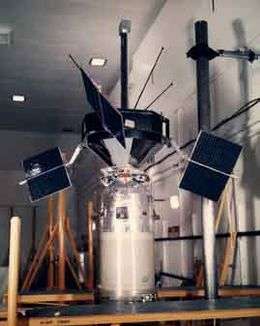Explorer 14
 | |
| Mission type | Earth science |
|---|---|
| Operator | NASA |
| Harvard designation | 1962 Beta Gamma 1 |
| SATCAT № | 432 |
| Mission duration | 10 months |
| Spacecraft properties | |
| Manufacturer | Goddard Space Flight Center |
| Launch mass | 40 kilograms (88 lb) |
| Start of mission | |
| Launch date | October 2, 1962, 22:11:30 UTC |
| Rocket | Delta A |
| Launch site | Cape Canaveral LC-17B |
| End of mission | |
| Last contact | August 11, 1963 |
| Decay date | May 25, 1988 |
| Orbital parameters | |
| Reference system | Geocentric |
| Regime | Highly elliptical |
| Semi-major axis | 78,707 kilometres (48,906 mi) |
| Eccentricity | 0.8389330 |
| Perigee | 2,601.0 kilometers (1,616.2 mi) |
| Apogee | 96,189.0 kilometers (59,769.1 mi) |
| Inclination | 42.80 degrees |
| Period | 2184.60 minutes |
| RAAN | 212.21 degrees |
| Mean anomaly | 333.98 degrees |
| Mean motion | 0.6673 |
| Epoch | 16 April 1965, 20:39:58 UTC |
| Revolution number | 122 |
Explorer 14 is a spin-stabilized, solar-cell-powered spacecraft instrumented to measure cosmic-ray particles, trapped particles, solar wind protons, and magnetospheric and interplanetary magnetic fields. A 16-channel PFM/PM time-division multiplexed telemeter was used. The time required to sample the 16 channels (one frame period) was 0.323 s. Half of the channels were used to convey eight-level digital information, and the others were used for analog information. During ground processing of the telemetered data, the analog information was digitized with an accuracy of 1/100 of full scale. One analog channel was subcommutated in a 16-frame-long pattern and was used to telemeter spacecraft temperatures, power system voltages, currents, etc. A digital solar aspect sensor measured the spin period and phase, digitized to 0.041 s, and the angle between the spin axis and sun direction to about 3-degree intervals.[1][2]
Experiments
There were eight experiments done on the Explorer 14 during its mission.[3]
- Proton Analyzer
- Fluxgate Magnetometers
- Trapped Particle Radiation
- Cosmic Rays
- Proton-Electron Scintillation Detector
- Solar Aspect Sensor
- Electrolytic Timer Experiment
- Solar Cell Damage Experiment
References
![]() This article incorporates public domain material from websites or documents of the National Aeronautics and Space Administration.
This article incorporates public domain material from websites or documents of the National Aeronautics and Space Administration.